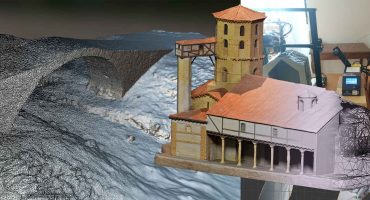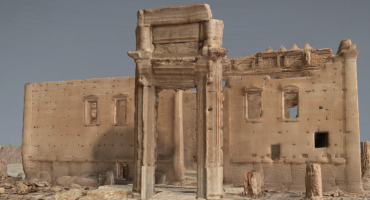About me, my work & background
My name is Mario Wallner, I studied Celtic Studies and have been working with prehistoric archaeology for 12 years.
My first career – as forester – connected me strongly with nature, therefore I still have a special passion for old, strangely shaped trees. However, I decided to add another dimension to my life and began to study Celtic Studies. Since graduating, I have been working in an Austrian research institute (LBI ArchPro), which deals with the non-destructive prospection of our cultural heritage. The digital visualization of my research results is therefore of great importance within my current work and spare time.
My first contact with photogrammetry was through a colleague who surprised me with a brand-new 3D documentation method in 2011. It was Photoscan by Agisoft, a software that was like magic – take a couple of photos, put them into the program and after a few minutes you get a colour realistic digital model. Since then, the documentation about Image Based Modelling (IBM) got me firmly under control and I’m trying to digitize the world around me.
LBI ArchPro
The Ludwig Boltzmann Institute for Archaeological Prospection and Virtual Archaeology (LBI ArchPro) is a research institute dedicated to the development of new techniques and methodological concepts for landscape archaeology. Its research programme combines geophysics, aerial imaging, computer science and geomatics to develop efficient and universally applicable approaches for the non-destructive detection, documentation, visualisation, analysis and interpretation of archaeological landscapes.
The Roman town of Carnuntum is the largest archaeological site in Austria and has been a major part of our institute’s research from the very beginning (visualisation by: 7reasons).
The Meillionydd project
As an archaeologist who is mainly interested in the Iron Age of Central Europe and Great Britain, I have been participating in archaeological excavations carried out by the University of Bangor (North Wales) since 2010. We started very early with the digital documentation of our excavation progress. Thus, we are now able to assemble most of the essential surfaces of 7 years of excavations in Virtual Reality. In this way we are able to visualize related structures of different excavation campaigns and to display individual construction phases of the Iron Age settlement.
We are using Sketchfab to prepare materials for the training of our young students; in this way we are able to share the results of our previous work using the VR-tool function. The students can navigate through the results of the previous excavations and thus understand the value of their work through the digital medium. During the training excavation great importance is laid on the training of the students in the handling of photogrammetric documentation.
VR for open-air museums – the ‘Keltendorf Mitterkirchen’
At the moment one of my favourite projects is the development of a virtual tour through two open-air museums, which were built for the communication of Iron Age settlement reconstructions. The Celtic village of Mitterkirchen shows a Hallstatt periode village (around 700 BC) of the lowlands.
The project, in cooperation with the ‘Oberösterreichisches Landesmuseum’ is still ongoing, but the final aim would be to embed the Sketchfab models in the existing homepage. In this way I hope to offer the visitors an additional possibility to explore the prehistoric buildings in Virtual Reality. The annotations in the model provide a perfect opportunity to communicate additional scientific content and to refer to certain areas of interest. This should give people who cannot visit the open-air museum, be it the far distance or their state of health, the opportunity to experience at least a virtual recreation of a prehistoric village. It would also offer an attractive opportunity to teach prehistory to school classes or to inform oneself before visiting the museum.
Keltendorf Schwarzenbach by Mario_Wallner on Sketchfab
The second open-air museum is the Celtic village at Schwarzenbach, where a fortified settlement from the Late Latène period (around 120 BC) was constructed. The prehistoric village consists of seven buildings and numerous other reconstructed structures such as gardens and fences. The interior of the houses with storage containers, cooking vessels and tools from the late Iron Age is intended to illustrate the everyday life of this period. In the coming months I would also like to provide the interior of the houses for the museum homepage.
Capturing old trees, a typical workflow
My special passion & challenge lies in the digitisation of impressive old trees. Although they are not man made, old trees have their special value within our cultural heritage. They were always, and are still, part of human activities. Unfortunately, these old trees are constantly threatened by man, natural disasters and their old age. For this reason, it is my aim to preserve at least an image of them and by sharing it with the public trying to establish a basic understanding that might help to protect them.
old trees by Mario_Wallner on Sketchfab
The challenge in creating a good model of big trees is not only to produce sufficient photos, but also to capture a certain atmosphere. For this the light and the entire ambience must be right. I therefore try to visit my beloved trees at different times of the year and occasionally the atmosphere is just right to create a beautiful model.
I create all models by using Photogrammetry (IBM) from the ground, using a simple Lumix DMC-TZ61 digital camera. To do this, first I walk around the object – always two steps to the side, taking a photo, two steps to the side, next photo, etc … Then I focus on single areas, where I had the feeling that I had not taken enough photo coverage yet. To align the photos, I still prefer Photoscan from Agisoft.
After creating a first mesh of the object, I use another program (Meshmixer) to edit the mesh. Most of the time, IMB models from the ground produce holes on the upper side of branches. In these areas unattractive bubbles are generated by interpolation in the mesh. To repair them I use the sculpting tool. The next step is to re-import the edited mesh into the photogrammetry program for the final texturing.
If there are still areas with texture errors, I correct them in a photo editing software. Unfortunately, I am not yet perfect in the creation of depth maps, but I am trying to improve. All in all it takes quite an effort to create an attractive model, but the satisfaction of a beautiful digital representation of a memory is worth the effort.
My favourite 3D scans
The Bronze Age mining in the salt mines of Hallstatt is one of the most important cultural heritage sites in Austria. Due to the kilometre-long, extremely narrow mining tunnels, it is particularly difficult to visit this archaeological site. Therefore, it is a particular pleasure for me to be able to visit this outstanding prehistoric site now in Virtual Reality.
The Meillionydd Project / Keltendorf Mitterkirchen / Keltendorf Schwarzenbach




